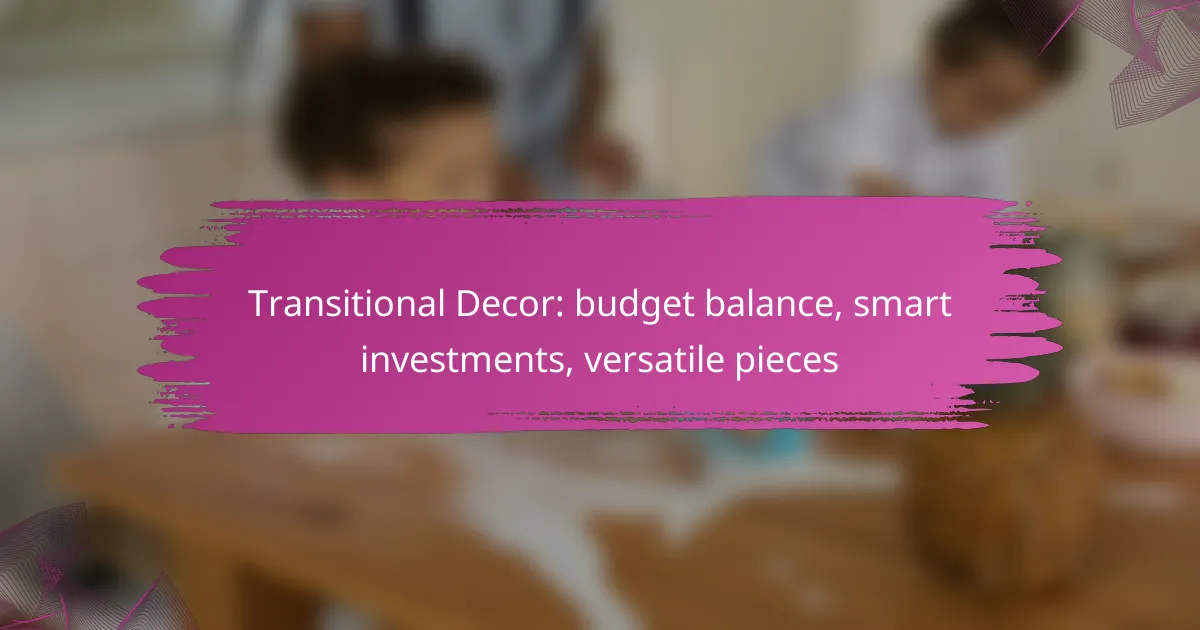Creating a balanced budget for transitional decor requires thoughtful planning and strategic investments in versatile pieces. By selecting items that blend traditional and contemporary styles, you can ensure your space remains stylish and functional while prioritizing quality for lasting appeal.

How to balance budget for transitional decor in Canada?
Balancing a budget for transitional decor in Canada involves careful planning and smart spending. Focus on versatile pieces that can adapt to different styles while prioritizing quality to ensure longevity.
Set a clear budget
Establishing a clear budget is the first step in managing your transitional decor expenses. Determine how much you can comfortably spend without compromising your financial stability.
Consider breaking your budget into categories such as furniture, accessories, and artwork. This will help you allocate funds appropriately and avoid overspending in any one area.
Prioritize essential pieces
Identify which items are essential for your transitional decor and prioritize those purchases. Key pieces like a versatile sofa or a neutral area rug can serve as a foundation for your design.
Focus on quality over quantity; investing in a few high-quality items will yield better results than filling your space with cheaper alternatives that may not last.
Explore second-hand options
Shopping second-hand can significantly reduce costs while still allowing you to find unique transitional decor items. Thrift stores, online marketplaces, and garage sales often have hidden gems.
Be open to refinishing or reupholstering items to fit your style. This approach not only saves money but also adds a personal touch to your decor.
Utilize seasonal sales
Take advantage of seasonal sales to purchase transitional decor at discounted prices. Major sales events like Black Friday or end-of-season clearances can offer substantial savings.
Sign up for newsletters from your favorite home decor retailers to stay informed about upcoming promotions and exclusive discounts.
Consider DIY projects
DIY projects can be a cost-effective way to enhance your transitional decor while adding a personal touch. Simple projects like painting furniture or creating wall art can transform a space without breaking the bank.
Research online tutorials and gather inspiration to help you get started. Just be sure to factor in the cost of materials to ensure your DIY efforts remain budget-friendly.

What are smart investments in transitional decor?
Smart investments in transitional decor focus on pieces that blend traditional and contemporary styles, providing versatility and longevity. Prioritizing quality, timeless aesthetics, and multi-functionality ensures that your decor remains relevant and appealing over time.
Invest in quality furniture
Quality furniture is essential for transitional decor as it combines durability with aesthetic appeal. Look for solid wood pieces or high-quality upholstery that can withstand daily use while maintaining their charm. Investing in a few key items, such as a sturdy dining table or a well-crafted sofa, can elevate your space significantly.
When selecting furniture, consider brands known for craftsmanship and longevity. While these pieces may come with a higher initial cost, they often save money in the long run due to their durability and timeless design.
Choose timeless color palettes
Timeless color palettes are crucial in transitional decor, as they create a cohesive and inviting atmosphere. Opt for neutral shades like beige, gray, or soft whites as a base, and incorporate accent colors that can easily be changed with accessories. This flexibility allows you to refresh your space without a complete overhaul.
Consider using color combinations that have stood the test of time, such as navy with white or earthy tones paired with pastels. These palettes not only enhance the aesthetic but also appeal to a broad range of tastes, making your decor more universally appealing.
Opt for multi-functional pieces
Multi-functional pieces are a smart investment in transitional decor, as they maximize space and utility. Look for items like ottomans that can serve as storage, or coffee tables that can extend for dining. These versatile options are particularly beneficial in smaller spaces where every square foot counts.
When shopping, prioritize items that can adapt to different needs or settings. For instance, a sofa bed can accommodate guests while maintaining a stylish living area. This approach not only saves money but also enhances the functionality of your home.
Research local artisans
Supporting local artisans can lead to unique finds that enhance your transitional decor. Local craftspeople often create one-of-a-kind pieces that reflect the character of your community, adding a personal touch to your space. Additionally, these items are often made with quality materials and craftsmanship.
Explore local markets, galleries, or online platforms that feature artisans in your area. Investing in handmade furniture or decor can provide a distinct aesthetic that mass-produced items lack, making your home feel more personalized and inviting.

Which versatile pieces enhance transitional decor?
Versatile pieces that enhance transitional decor blend traditional and contemporary styles, creating a cohesive and inviting space. Key items include modular sofas, adjustable lighting fixtures, area rugs with neutral tones, and decorative storage solutions.
Modular sofas
Modular sofas are ideal for transitional decor as they offer flexibility in arrangement and style. They can be reconfigured to suit different spaces and occasions, making them a smart investment for various room layouts.
When selecting a modular sofa, consider options with neutral upholstery to ensure compatibility with both traditional and modern elements. Look for pieces that allow for easy expansion or reconfiguration, accommodating changing needs over time.
Adjustable lighting fixtures
Adjustable lighting fixtures enhance transitional decor by providing both functionality and aesthetic appeal. These fixtures can be modified to create different atmospheres, from bright task lighting to soft ambient illumination.
Choose fixtures that combine classic designs with modern technology, such as dimmable LED options. This allows you to adjust the light intensity based on the time of day or activity, ensuring your space remains versatile and inviting.
Area rugs with neutral tones
Area rugs in neutral tones are essential for grounding transitional decor, as they can seamlessly tie together various design elements. They provide a visual anchor while allowing other decor features to shine.
Opt for rugs made from durable materials that can withstand foot traffic, such as wool or synthetic fibers. A well-placed rug can delineate spaces within an open floor plan, enhancing both functionality and style.
Decorative storage solutions
Decorative storage solutions are crucial for maintaining a clutter-free environment in transitional decor. They combine practicality with style, helping to keep your space organized while contributing to the overall design aesthetic.
Look for storage options that feature clean lines and versatile finishes, such as wood or metal. Items like woven baskets, stylish cabinets, or decorative boxes can serve as both storage and decor, enhancing the transitional feel of your home.

What criteria should be considered for selecting transitional decor?
Selecting transitional decor involves balancing modern and traditional elements to create a cohesive look. Key criteria include evaluating space dimensions, assessing lifestyle needs, and considering future trends to ensure your decor remains functional and stylish over time.
Evaluate space dimensions
Understanding the dimensions of your space is crucial when selecting transitional decor. Measure the area to determine the appropriate size of furniture and decor items, ensuring they fit well without overwhelming the room. For instance, a large sectional may work in a spacious living room but could crowd a smaller area.
Consider the layout as well; open spaces may benefit from larger pieces that anchor the room, while smaller spaces might require multi-functional furniture that maximizes usability. Aim for a balance that maintains flow and accessibility.
Assess lifestyle needs
Your lifestyle significantly influences your decor choices. If you have children or pets, opt for durable materials that can withstand wear and tear, such as leather or treated fabrics. Transitional decor should reflect your daily activities and preferences, ensuring comfort and practicality.
Think about how often you entertain guests or engage in hobbies. For example, if you frequently host gatherings, consider a layout that encourages conversation and includes ample seating. Prioritize pieces that align with your routines and enhance your living experience.
Consider future trends
Staying informed about future trends can help you make smart investments in transitional decor. Look for versatile pieces that can adapt to changing styles, such as neutral-colored sofas or timeless accent chairs. These items can easily blend with new trends without requiring a complete overhaul of your decor.
Research emerging design trends through magazines, online platforms, and social media to identify what resonates with you. Keep an eye on sustainable materials and eco-friendly practices, as these are increasingly popular and may enhance the longevity of your decor choices.
